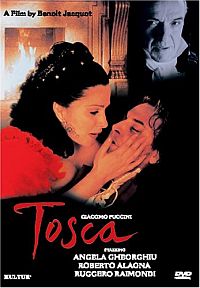Opera Film: Tosca [] Teatro Santa Ana at La Biblioteca
Event Category: La Biblioteca and Films
-
Opera Film: Tosca
Teatro Santa Ana
English
$70 pesos
The opera begins without any prelude; the opening chords of the Scarpia motif lead immediately to the agitated appearance of Angelotti and the enunciation of the “fugitive” motif. The sacristan’s entry, accompanied by his sprightly buffo theme, lifts the mood, as does the generally light-hearted colloquy with Cavaradossi which follows after the latter’s entrance. This leads to the first of the “Grand Tunes”, Cavaradossi’s “Recondita armonia” with its sustained high B flat, accompanied by the sacristan’s grumbling counter-melody. The domination, in that aria, of themes which will be repeated in the love duet make it clear that though the painting may incorporate the Marchesa’s features, Tosca is the ultimate inspiration of his work. Cavaradossi’s dialogue with Angelotti is interrupted by Tosca’s arrival, signalled by her motif which incorporates, in Newman’s words, “the feline, caressing cadence so characteristic of her.”Though Tosca enters violently and suspiciously, the music paints her devotion and serenity. According to Budden, there is no contradiction: Tosca’s jealousy is largely a matter of habit, which her lover does not take too seriously.After Tosca’s “Non la sospiri” and the subsequent argument inspired by her jealousy, the sensuous character of the love duet “Qual’occhio” provides what opera writer Burton Fisher describes as “an almost erotic lyricism that has been called pornophony”. The brief scene in which the sacristan returns with the choristers to celebrate Napoleon’s supposed defeat provides almost the last carefree moments in the opera; after the entrance of Scarpia to his menacing theme, the mood becomes sombre, then steadily darker.As the police chief interrogates the sacristan, the “fugitive” motif recurs three more times, each time more emphatically, signalling Scarpia’s success in his investigation. In Scarpia’s exchanges with Tosca the sound of tolling bells, interwoven with the orchestra, creates an almost religious atmosphere, for which Puccini draws on music from his then unpublished Mass of 1880.[79] The final scene in the act is a juxtaposition of the sacred and the profane,[74] as Scarpia’s lustful reverie is sung alongside the swelling Te Deum chorus. He joins with the chorus in the final statement “Te aeternum Patrem omnis terra veneratur” (“Everlasting Father, all the earth worships thee”), before the act ends with a thunderous restatement of the Scarpia motif.[
-
-

